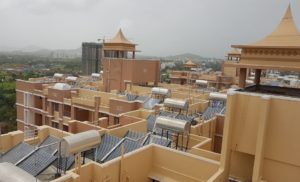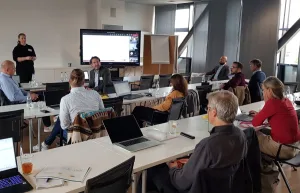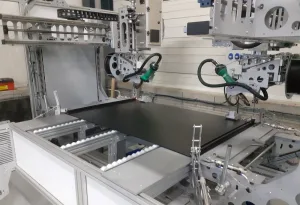

Hungary: Great Interest in Expired Residential Subsidy Scheme
 The Hungarian Ministry of National Development reported a high interest in one of its recently halted support programmes. According to the ministry’s statement from 17 May, it received 5,686 applications for the “Sub programme to set up solar collector systems that facilitate the use of renewable energies, generate residential hot water and provide space heating”. The ministry also stated that 2,300 of these applications have already been approved: “The total amount requested in the applications reaches the Hungarian Forint (HUF) 2.97 billion (EUR 10 million) available.” The sub programme was launched at the beginning of October 2011 and expired – after several extensions – on 15 May 2012.
The Hungarian Ministry of National Development reported a high interest in one of its recently halted support programmes. According to the ministry’s statement from 17 May, it received 5,686 applications for the “Sub programme to set up solar collector systems that facilitate the use of renewable energies, generate residential hot water and provide space heating”. The ministry also stated that 2,300 of these applications have already been approved: “The total amount requested in the applications reaches the Hungarian Forint (HUF) 2.97 billion (EUR 10 million) available.” The sub programme was launched at the beginning of October 2011 and expired – after several extensions – on 15 May 2012.
The scheme has been financed through revenues from the international sale of emissions credits (known as Assigned Amount Units) and is managed by state-owned ÉMI Nonprofit Kft. The solar thermal sub programme allowed private persons and associations of home owners with up to twelve flats to apply for incentives amounting to 50% of the costs needed to acquire and install a solar water heating system. The application limit was HUF 800,000 (EUR 2,640) per flat. The programme’s regulations stipulate that any of the eligible systems have to be installed until 30 September 2012. The scheme is part of the “New Széchenyi Plan Green Investment Scheme” (GIS) and follows Hungary´s National Energy Strategy.
Pál Varga appreciates the success of the now expired solar thermal subsidy scheme and expects significant market growth in the coming months. The Head of the solar thermal group within the Hungarian Solar Energy Society says that “the scheme could help install 5,000 new solar collector systems”. This would correspond to a total glazed collector area of 50,000 m2, which would be 2.5 times more than last year’s 20,000 m2. Varga could be rightly called a pioneer in the field of solar thermal energy in Hungary. In the 1990s, he founded the solar thermal section of the Alliance of Hungarian Building Engineers, whose chairman he is today. The data he gathered of the Hungarian market between 2001 and 2011 shows the installation of round about 170,000 m2 of glazed solar thermal collectors with a capacity of 119 MWth during that period. Flat plate collectors make up more than 80% of the market volume; the remaining 20% are vacuum collectors.
Ernö Kiss shares Varga´s optimism regarding the effects of the incentive programme. Kiss is chairman of the Hungarian Photovoltaics and Solar Collector Association, a 70-member organisation founded in 2010. “The investment support is a strong motivational factor in Hungary. 2012’s sales figures are going to reflect the success of the subsidy scheme,” Kiss hopes.
Béla Glattfelder, Member of the European Parliament and President of the Hungarian solar association (see http://www.solarthermalworld.org/node/2853), is convinced that the decision makers have become friendlier to the industry because of increasing public support for renewables: “We can now see the effects of our campaigning for green energy.” Glattfelder thinks that “support programmes are important, but it´s a pity that execution is slow”. Still, the last round of subsidies since November 2011 has been the biggest one yet. More than 800 companies have been involved in its implementation. Glattfelder calls it “an industrial base for future progress”. But, he thinks it will not be enough to meet the targets of the National Renewable Energy Action Plan (NREAP). “Until now, we have an installed capacity of about 3 ktoe. But, our target for 2020 is 56 ktoe,” Glattfelder says.
The national associations have been criticising the stop-and-go policy of the government. “The lack of stable support schemes for individuals jeopardises the business prospects of Hungarian solar energy companies,” climate policy institute Energiaklub complains in his 2011 report. Varga shares the institute’s view. “The Hungarian market for solar thermal systems came to a halt between 2009 and 2011. During that time, the Hungarian government did not run a proper support scheme for thermal solar installations in Hungary,” Varga says.
“Currently, we have no information on a new subsidy round for residential applicants within GIS,” says Lilla Csanaky, Renewable Energy Project Manager at Energiaklub. “But, there is a tender planned in 2012 within the EU Operational Programme ‘Environment and Energy’.” The tender will be open to municipalities, enterprises and the public sector. According to Glattfelder, the new incentive programme for renewable energy sources, including solar collectors, could have a budget of EUR 133 million.
More information:
Hungarian Ministry of National Development – Green Investment Scheme: http://www.zbr.kormany.hu/en
Magyar Napenergia Társaság (Hungarian Sun Energy Association): http://fft.szie.hu/mnt/
Magyar Szolár Szövetség (Hungarian Solar Association): http://www.maszolar.hu/
Magyar Napelem Napkollektor Szövetség (Hungarian Solar Cell Sun Collector Alliance): http://www.mnnsz.hu/
Magyar Épületgépészek Napenergia Szövetsége (MÉGNAP, Solar Thermal Association of Hungarian Building Engineers): http://www.megsz.hu,
Climate Policy Institute Energiaklub: http://www.energiaklub.hu/en


